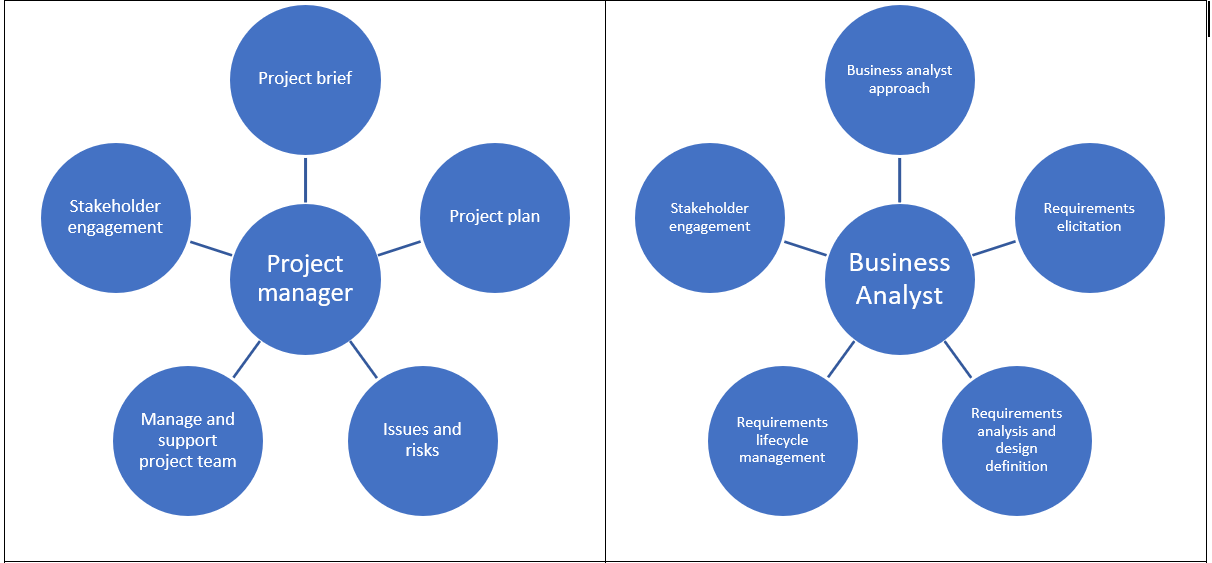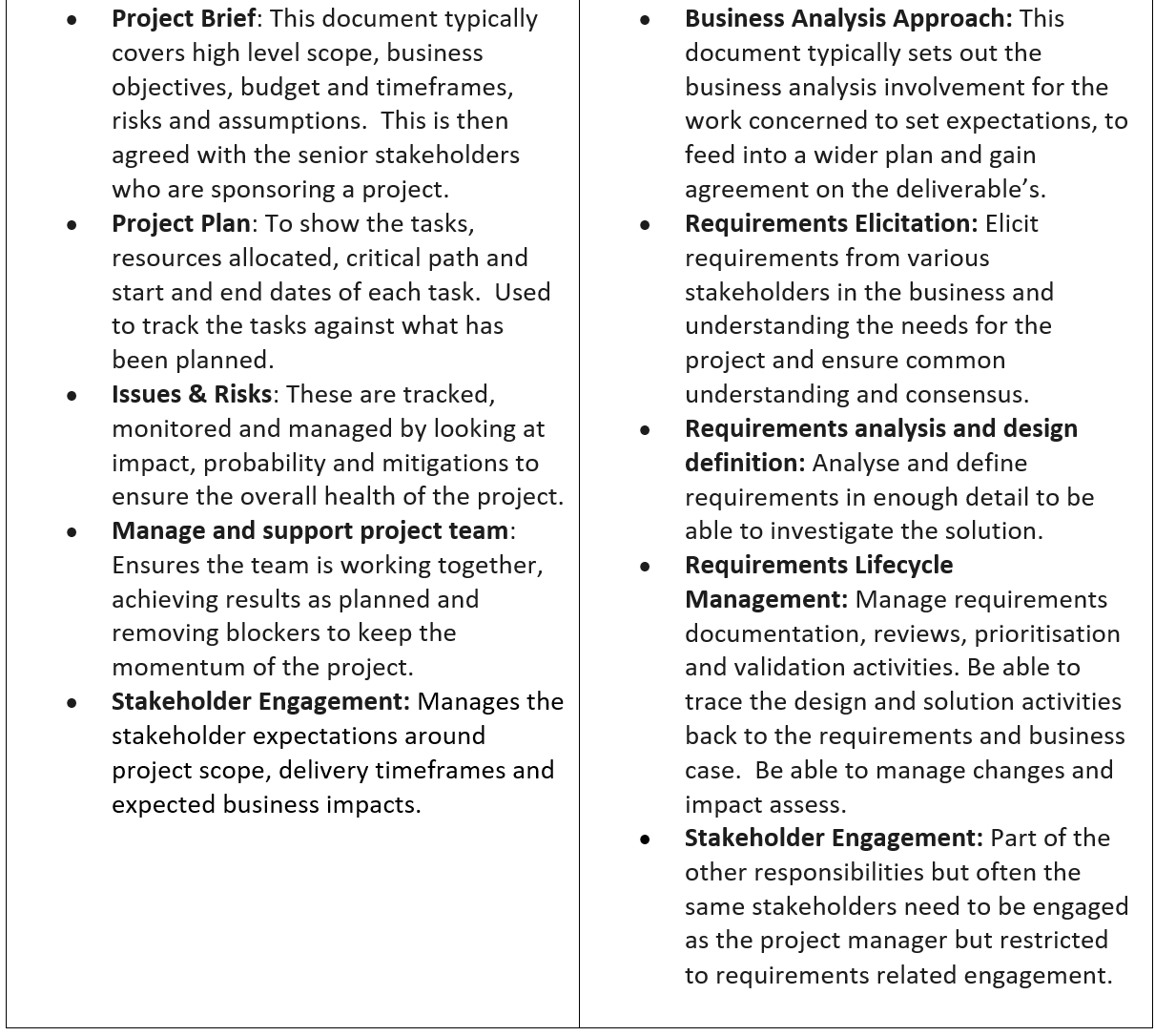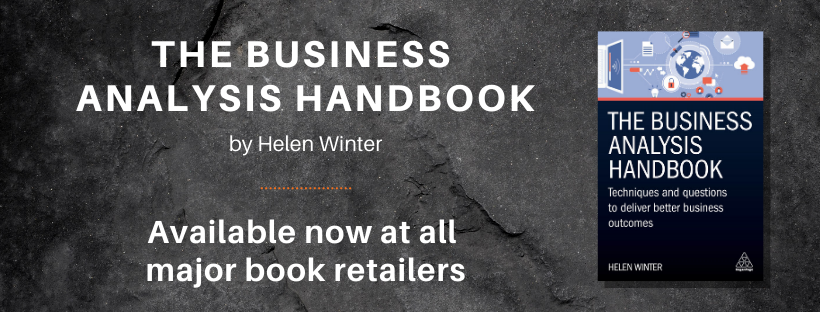
Introduction
This article is about the collaboration required between the project manager and business analyst. They both contribute to project delivery but from different perspectives.
Summary of the different responsibilities.
A project manager has the overall responsibility for the successful initiation, planning, design, execution, monitoring, controlling and closure of a project. Their focus is on delivery within scope, budget, timescales and managing risk.
A business analyst has involvement to a lower level of detail supporting all of the areas the project manager is responsible for. Their focus is being the voice of the business, ensuring the solution maps back to the requirements and the business can live with the project solution once it is delivered.


Overlaps
The areas of overlap tend to be around setting out the vision, planning and stakeholder engagement.
The involvement of pre-project work and setting out the vision and high-level business needs tends to vary by organisation. Depending upon the organisational structure it can be led by the project manager, the business analyst or a mixture of both.
The project manager may have overall responsibility for the project plan but the business analyst should be responsible for providing the business analysis activities and estimated effort to feed into the plan. This should be set out in the business analysis approach document. If alignment isn’t done between the project manager and the business analyst there may be a mismatch and the quality of the requirements could suffer.
As explained in the table above the project manager and business analyst both are involved with stakeholder engagement and often with the same set of stakeholders. This can lead to one or the other not being involved in meetings that affect them. It is therefore important for the business analyst and project manager to understand the difference in the information they receive so they can ensure the other party is involved where relevant. For instance, if stakeholders speak about business requirements to the project manager they could ensure the stakeholder is asked to raise with the business analyst and likewise if the stakeholders talk to the business analyst about project delivery timeframes then the business analyst should refer them to the project manager.
What can be done to encourage a harmonious relationship
Below are some tips to encourage a harmonious relationship:
An organisation can support this by:
- Ensuring clear roles and responsibilities documented between the project manager and business analyst to help ensure knowledge of each other’s roles and perspectives.
- Process to involve the business analyst early in the engagement process and during the vision stage. The business analyst and project manager have different skillsets that will complement each other in this stage to give a fuller understanding of the problems to be resolved, opportunities, business needs and details to support the business case.
- Clear project governance to ensure the business analysis stages are not missed out and requirements gates are in place. Having them as a standard part of the governance process will help empower the business analyst to play a more equal role in the project as when timelines get squeezed it can be tempting for the project manager to see what can be cut out.
- To have a clear set of standard deliverables and standard templates setting out what is required from the business analyst to increase the understanding of the complexity and quality of work required and its benefits.
Projects can support this by:
- Ensuring the business analyst feels empowered to set out what they need to do, to communicate the business analysis approach required and provide their own estimates which feed into the overall project plan. There needs to be negotiation between the business analyst and project manager on how much time is required to do business analysis tasks.
- Provide easy access to business analysts to raise risks and issues as they will generally come across warning signs of issues well before anyone else. A separate flag controlled by the project manager can be used to indicate which ones need to be escalated at the appropriate points.
- Good communication, a close working relationship with regular updates. It may be helpful for them to sit near each other to aid frequent conversations.
- Joint working on key deliverables such as the business case which overlaps between defining business requirements and scope, objectives, project timeframes and costs.
Thoughts? Questions? Please share in the comments.
If you have found this article useful then you might like my book – The Business Analysis Handbook – Techniques and Questions for better Business Outcomes. The book is available from www.koganpage.com and all major print and e-book retailers.

